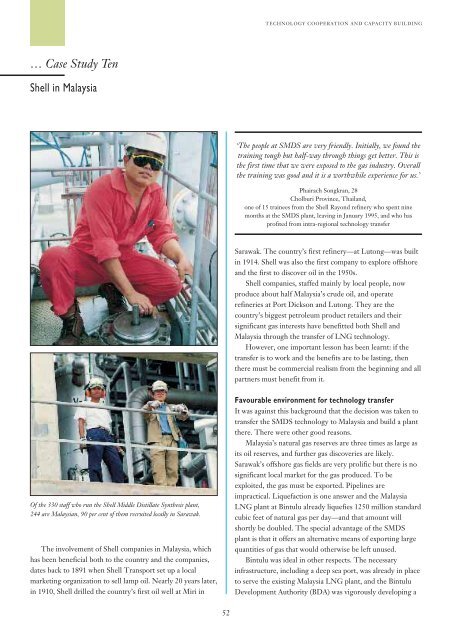Technology Cooperation and Capacity Building - CommDev
Technology Cooperation and Capacity Building - CommDev
Technology Cooperation and Capacity Building - CommDev
Create successful ePaper yourself
Turn your PDF publications into a flip-book with our unique Google optimized e-Paper software.
TECHNOLOGY COOPERATION AND CAPACITY BUILDING… Case Study TenShell in Malaysia‘The people at SMDS are very friendly. Initially, we found thetraining tough but half-way through things get better. This isthe first time that we were exposed to the gas industry. Overallthe training was good <strong>and</strong> it is a worthwhile experience for us.’Phairach Songkran, 28Cholburi Province, Thail<strong>and</strong>,one of 15 trainees from the Shell Rayond refinery who spent ninemonths at the SMDS plant, leaving in January 1995, <strong>and</strong> who hasprofited from intra-regional technology transferSarawak. The country’s first refinery—at Lutong—was builtin 1914. Shell was also the first company to explore offshore<strong>and</strong> the first to discover oil in the 1950s.Shell companies, staffed mainly by local people, nowproduce about half Malaysia’s crude oil, <strong>and</strong> operaterefineries at Port Dickson <strong>and</strong> Lutong. They are thecountry’s biggest petroleum product retailers <strong>and</strong> theirsignificant gas interests have benefitted both Shell <strong>and</strong>Malaysia through the transfer of LNG technology.However, one important lesson has been learnt: if thetransfer is to work <strong>and</strong> the benefits are to be lasting, thenthere must be commercial realism from the beginning <strong>and</strong> allpartners must benefit from it.Of the 330 staff who run the Shell Middle Distillate Synthesis plant,244 are Malaysian, 90 per cent of them recruited locally in Sarawak.The involvement of Shell companies in Malaysia, whichhas been beneficial both to the country <strong>and</strong> the companies,dates back to 1891 when Shell Transport set up a localmarketing organization to sell lamp oil. Nearly 20 years later,in 1910, Shell drilled the country’s first oil well at Miri inFavourable environment for technology transferIt was against this background that the decision was taken totransfer the SMDS technology to Malaysia <strong>and</strong> build a plantthere. There were other good reasons.Malaysia’s natural gas reserves are three times as large asits oil reserves, <strong>and</strong> further gas discoveries are likely.Sarawak’s offshore gas fields are very prolific but there is nosignificant local market for the gas produced. To beexploited, the gas must be exported. Pipelines areimpractical. Liquefaction is one answer <strong>and</strong> the MalaysiaLNG plant at Bintulu already liquefies 1250 million st<strong>and</strong>ardcubic feet of natural gas per day—<strong>and</strong> that amount willshortly be doubled. The special advantage of the SMDSplant is that it offers an alternative means of exporting largequantities of gas that would otherwise be left unused.Bintulu was ideal in other respects. The necessaryinfrastructure, including a deep sea port, was already in placeto serve the existing Malaysia LNG plant, <strong>and</strong> the BintuluDevelopment Authority (BDA) was vigorously developing a52















![[PDF] Community Development Toolkit - CommDev](https://img.yumpu.com/48616495/1/184x260/pdf-community-development-toolkit-commdev.jpg?quality=85)
